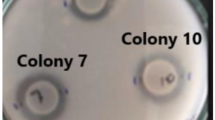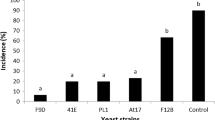Abstract
Two antagonistic yeast strains Metschnikowia pulcherrima MACH1 and Rhodotorula sp. PW34 were tested for their efficacy against Botrytis cinerea in vitro and in vivo on apples. Metschnikowia pulcherrima strain MACH1 showed higher inhibition of B. cinerea compared to the strain PW34 in vitro on potato dextrose broth. Further, yeast strain MACH1 showed higher efficacy in reducing grey mould on apples compared to PW34 and the untreated control. In addition, partially purified extracellular proteins from strain MACH1 showed an inhibition to B. cinerea in vitro. The antagonistic yeast strains were tested for their efficacy to produce chitinases in different liquid media, including apple juice, amended with or without cell wall preparations (CWP) of B. cinerea. The study showed a higher production of chitinases from M. pulcherrima strain MACH1 when compared to PW34. Interestingly, the strain MACH1 secreted higher chitinases in the presence of cell wall fractions of B. cinerea. For this reason, the chitinase gene of strain MACH1 was amplified using PCR reactions and the nucleotide sequence data showed high homology to chitinases of other yeast strains. The results of the current study show that M. pulcherrima strain MACH1 has the ability to secrete chitinases in different liquid media including apple juice, and the enzyme could be involved in the post-harvest biological control of B. cinerea.



Similar content being viewed by others
References
Boller, T., & Mauch, F. (1988). Colorimetric assay for chitinase. Methods In Enzymology, 161, 430–435.
Bougoure, D. S., & Cairney, J. W. G. (2006). Chitinolytic activities of ericoid mycorrhizal and other root-associated fungi from Epacris pulchella (Ericaceae). Mycological Research, 110, 328–334.
Bradford, M. M. (1976). A rapid and sensitive method for quantification of microgram quantities of protein utilizing the principle of protein-dye binding. Analytical Biochemistry, 72, 248–254.
Calvente, V., Benuzzi, D., & de Tosetti, M. I. S. (1999). Antagonistic action of siderophores from Rhodotorula glutinis upon the postharvest pathogen Penicillium expansum. International Biodeterioration & Degradation, 43, 167–172.
Calvente, V., de Orellano, M. E., Sansone, G., Benuzzi, D., & Tosetti, M. I. S. (2001). Effect of nitrogen source and pH on siderophore production by Rhodotorula strains and their application to biocontrol phytopathogenic moulds. Journal of Industrial Microbiology & Biotechnology, 26, 226–229.
Castoria, R., De Curtis, F., Lima, G., Caputo, L., Pacifico, S., & De Cicco, V. (2001). Aureobasidium pullulans (LS-30) an antagonist of postharvest pathogens of fruits: Study on its modes of action. Postharvest Biology & Technology, 22, 7–17.
Chernin, L. S., De La Fuente, L., Sobolev, V., Haran, S., Vorgias, C. E., Oppenheim, A. B., et al. (1997). Molecular cloning, structural analysis, and expression in Escherichia coli of a chitinase gene from Enterobacter agglomerans. Applied Environmental Microbiology, 63(3), 834–839.
Dana, M. M., Limon, M. C., Mejıàs, R., Mach, R. L., Benıtez, T., Pintor-Toro, J. A., et al. (2001). Regulation of chitinase 33 (chit33) gene expression in Trichoderma harzianum. Current Genetics, 38, 335–342.
Daniel, H. M., Sorrell, T. C., & Meyer, W. (2001). Partial sequence analysis of the actin gene and its potential for studying the phylogeny of Candida species and their teleomorphs. International Journal of Systematic and Evolutionary Microbiology, 51, 1593–1606.
De Curtis, E., Torriani, S., Rossi, E., & De Cicco, V. (1996). Selection and use of Metschnikowia pulcherrima as a biological control agent for postharvest rots of peaches and table grapes. Annals of Microbiology, 46, 45–55.
Eckert, J. W., & Ogawa, J. M. (1985). The chemical control of postharvest diseases: Subtropical and tropical fruits. Annual Review of Phytopathology, 23, 421–454.
Eckert, J. W., Sievert, J. R., & Ratnayake, M. (1994). Reduction of imazalil effectiveness against citrus green mold in California packinghouses by resistant biotypes of Penicillium digitatum. Plant Disease, 78, 971–974.
Elad, Y., Chet, I., & Henis, Y. (1982). Degradation of plant pathogenic fungi by Trichoderma harzianum. Canadian Journal of Microbiology, 28, 719–725.
El-Ghaouth, A., Wilson, C. L., & Wisniewski, M. (1998). Ultrastructural and cytochemical aspects of the biological control of Botrytis cinerea by Candida saitoana in apple fruit. Phytopathology, 88, 282–291.
El-Katatny, M. H., Somitsch, W., Robra, K. H., E-Katatny, M. S., & Gübitz, G. M. (2000). Production of chitinase and β-1,3-glucanase by Trichoderma harzianum for control of the phytopathogenic fungus Sclerotium rolfsii. Food Technology and Biotechnology, 38, 173–180.
Freeman, S., Minzm, O., Kolesnik, I., Barbul, O., Zveibil, A., Maymon, M., et al. (2004). Trichoderma biocontrol of Colletotrichum acutatum and Botrytis cinerea and survival in strawberry. European Journal of Plant Pathology, 110, 361–370.
Funkhouser, J. D., & Aronson, N. N. (2007). Chitinase family GH18: Evolutionary insights from the genomic history of a diverse protein family. BMC Evolutionary Biology, 7, 96.
Gohel, V., Singh, A., Vimal, M., Ashwini, P., & Chatpat, H. S. (2006). Bioprospecting and antifungal potential of chitinolytic microorganisms. African Journal of Biotechnology, 5(2), 54–72.
Harish, S., Manjula, K., & Podile, A. R. (1998). Fusarium udum is resistant to the mycolytic activity of a biocontrol strain of Bacillus subtilis AF1. FEMS Microbiology Ecology, 25, 385–390.
Huang, C., Wang, T., Chung, S., & Chen, C. (2005). Identification of an antifungal chitinase from a potential biocontrol agent, Bacillus cereus 28-9. Journal of Biochemistry and Molecular Biology, 38, 82–88.
Janisiewicz, W. J., & Korsten, L. (2002). Biological control of postharvest diseases of fruits. Annual Review of Phytopathology, 40, 411–441.
Janisiewicz, W. J., Tworkoski, T. J., & Kurtzman, C. P. (2001). Biocontrol potential of Metchnikowia pulcherrima strains against blue mold of apple. Phytopathology, 91, 1098–1108.
Jijakli, M. W., & Lepoivre, P. (1998). Characterization of an Exo-β-1,3-glucanase produced by Pichia anomala strain K, antagonist of Botrytis cinerea on apples. Phytopathology, 88, 335–343.
Joo, G. (2005). Purification and characterization of an extracellular chitinase from the antifungal biocontrol agent Streptomyces halstedii. Biotechnology Letters, 27, 1483–1486.
Kaur, J., Munshi, G. D., Singh, R. S., & Koch, E. (2005). Effect of carbon source on production of lytic enzymes by the sclerotial parasites Trichoderma atroviride and Coniothyrium minitans. Journal of Phytopathology, 153, 274–279.
Kobayashi, D. Y., Reedy, R. M., Bick, J. A., & Oudemans, P. V. (2002). Characterization of a chitinase gene from Stenotrophomonas maltophilia strain 34S1 and its involvement in biological control. Applied Environment and Microbiology, 68, 1047–1054.
Kurtzman, C. P., & Droby, S. (2001). Metschnikowia fructicola, a new ascosporic yeast with potential for biocontrol of postharvest fruit rots. Systematic and Applied Microbiology, 24, 395–399.
Leverentz, B., Conway, W. S., Janisiewicz, W., Abadias, M., Kurtzman, C. P., & Camp, M. J. (2006). Biocontrol of the food-borne pathogens Listeria monocytogenes and Salmonella enterica serovar. Poona on fresh-cut apples with naturally occurring bacterial and yeast antagonists. Applied Environment and Microbiology, 72, 1135–1140.
Maniatis, T. E., Fritsch, E. F., & Sambrook, J. (1982). Molecular cloning: A laboratory manual. Cold Spring Harbor: Cold Spring Harbor Laboratory.
Masih, E. I., & Paul, B. (2002). Secretion of beta-1,3-glucanases by the yeast Pichia membranifaciens and its possible role in the biocontrol of Botrytis cinerea causing grey mould disease of the grapevine. Current Microbiology, 44, 391–395.
McCreath, K. J., Specht, C. A., & Robbins, P. W. (1995). Molecular cloning and characterization of chitinase genes from Candida albicans. Proceedings of National Academy of Science, 92, 2544–2548.
Piano, S., Neyrotti, V., Migheli, Q., & Gullino, M. L. (1997). Characterization of the biocontrol capability of Metschnikowia pulcherrima against Botrytis postharvest rot of apple. Postharvest Biology Technology, 11, 131–140.
Saligkarias, I. D., Gravanis, F. T., & Eptona, H. A. S. (2002). Biological control of Botrytis cinerea on tomato plants by the use of epiphytic yeasts Candida guilliermondii strains 101 and US 7 and Candida oleophila strain I-182: II. A study on mode of action. Biological Control, 25, 151–161.
Saravanakumar, D., Ciavorella, A., Spadaro, D., Garibaldi, A., & Gullino, M. (2008). Metschnikowia pulcherrima strain MACH1 outcompetes Botrytis cinerea, Alternaria alternata and Penicillium expansum in apples through iron depletion. Postharvest Biology and Technology, 49, 121–128.
Schena, L., Ippolito, A., Zahavi, T., Cohen, L., & Droby, S. (2000). Molecular approaches to assist the screening and monitoring of postharvest biological yeasts. European Journal of Plant Pathology, 106, 681–691.
Smilanick, J. L. (1994). Strategies for the isolation and testing of biocontrol agents. In C. L. Wilson, & M. E. Wisniewski (Eds.), Biological control of postharvest diseases—Theory and practice (pp. 25–42). Boca Raton: CRC.
Spadaro, D., Ciavorella, A., Garibaldi, A., & Gullino, M. L. (2005). Ampliamento dello spettro d’azione di lieviti antagonisti per la lotta biologica in post-raccolta su pomacee. Informatore fitopatologico-La Difesa delle Piante, 55(10), 56–59.
Spadaro, D., Garibaldi, A., & Gullino, M. L. (2004). Control of Penicillium expansum and Botrytis cinerea on apple combining a biocontrol agent with hot water dipping and acibenzolar-S-methyl, baking soda, or ethanol application. Postharvest Biology and Technology, 33, 141–151.
Spadaro, D., & Gullino, M. L. (2004). State of art and future perspectives of biological control of postharvest fruit diseases. International Journal of Food Microbiology, 91, 185–194.
Spadaro D., Sabetta W., Acquadro A., Portis E., Garibaldi A., Gullino M. L. (2008). Use of AFLP for differentiation of Metschnikowia pulcherrima strains for postharvest disease biological control. Microbiological Research. doi:10.1016/j.micres.2007.01.004.
Spadaro, D., Vola, R., Piano, S., & Gullino, M. L. (2002). Mechanisms of action, efficacy and possibility of integration with chemicals of four isolates of the yeast Metschnikowia pulcherrima active against postharvest pathogens on apples. Postharvest Biology and Technology, 24, 123–134.
Stafford, W. H. L., Baker, G. C., Brown, S. A., Burton, S. G., & Cowan, D. A. (2005). Bacterial diversity in the rhizosphere of proteaceae species. Environmental Microbiology, 11, 1175–1768.
Vaidya, R., Roy, S., Macmil, S., Gandhi, S., Vyas, P., & Chhatpar, H. S. (2003). Purification and characterization of chitinase from Alcaligenes xylosoxydans. Biotechnology Letters, 25, 715–717.
White, T. J., Bruns, T., Lee, S., & Taylor, J. (1990). Amplification and direct sequencing of fungal ribosomal RNA genes for phylogenetics. In M. A. Innis, D. H. Gelfand, J. J. Shinsky, & T. J. White (Eds.), PCR protocols: A guide to methods and applications (pp. 315–322). San Diego: Academic.
Wilson, C. L., & Wisniewski, M. E. (1994). Biological control of postharvest diseases—Theory and practice. Boca Raton: CRC.
Wisniewski, M. E., Biles, C., Droby, S., Mclaughlin, R., Wilson, C. L., & Chalutz, E. (1991). Mode of action of the postharvest biocontrol yeast, Pichia guilliermondii. I. Characterization of attachment to Botrytis cinerea. Physiology and Molecular Plant Pathology, 39, 245–258.
Acknowledgements
This research was carried out partly with a grant from the Piedmont Region for the project ‘Selection, study of the efficacy and of the mechanism of action, characterisation and development of antagonistic yeasts against post-harvest fruit pathogens’ and partly with a grant from the Italian Ministry for the Environment, Land and Sea within the Framework Agreement ‛‘Sustainable Agriculture’ to AGROINNOVA. Duraisamy Saravanakumar acknowledges the Italian Ministry for University Research and the Compagnia di San Paolo for the post-doctoral grant ‛‘Bando per borse a favore di giovani ricercatori indiani’.
Author information
Authors and Affiliations
Corresponding author
Rights and permissions
About this article
Cite this article
Saravanakumar, D., Spadaro, D., Garibaldi, A. et al. Detection of enzymatic activity and partial sequence of a chitinase gene in Metschnikowia pulcherrima strain MACH1 used as post-harvest biocontrol agent. Eur J Plant Pathol 123, 183–193 (2009). https://doi.org/10.1007/s10658-008-9355-5
Received:
Accepted:
Published:
Issue Date:
DOI: https://doi.org/10.1007/s10658-008-9355-5




